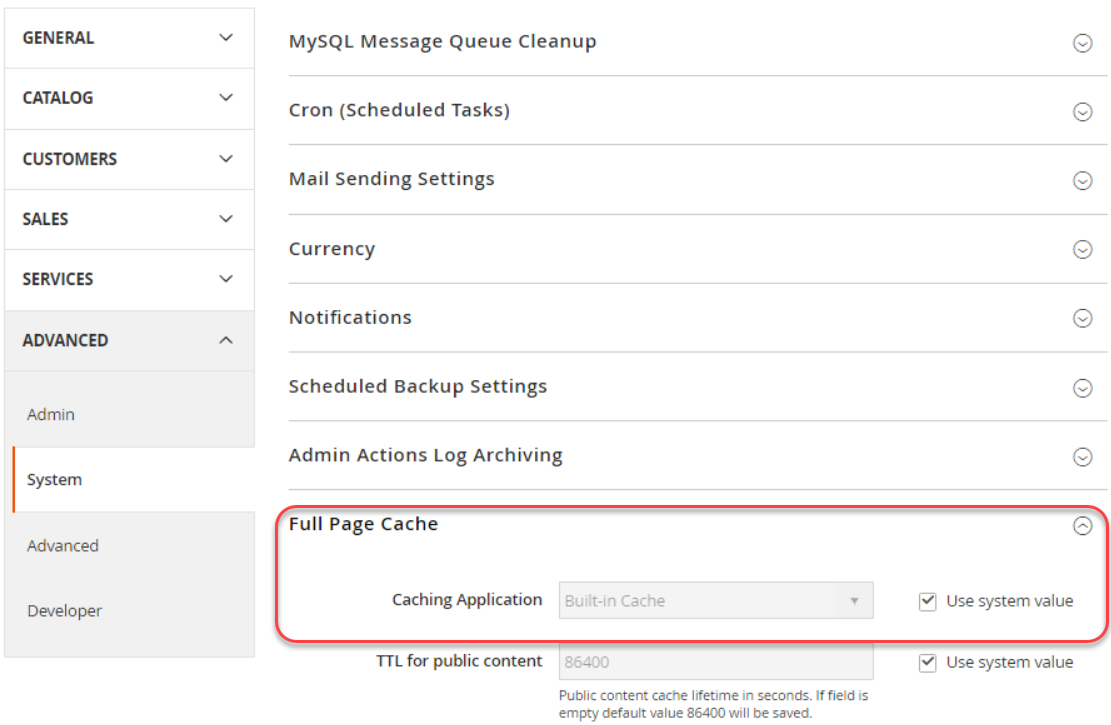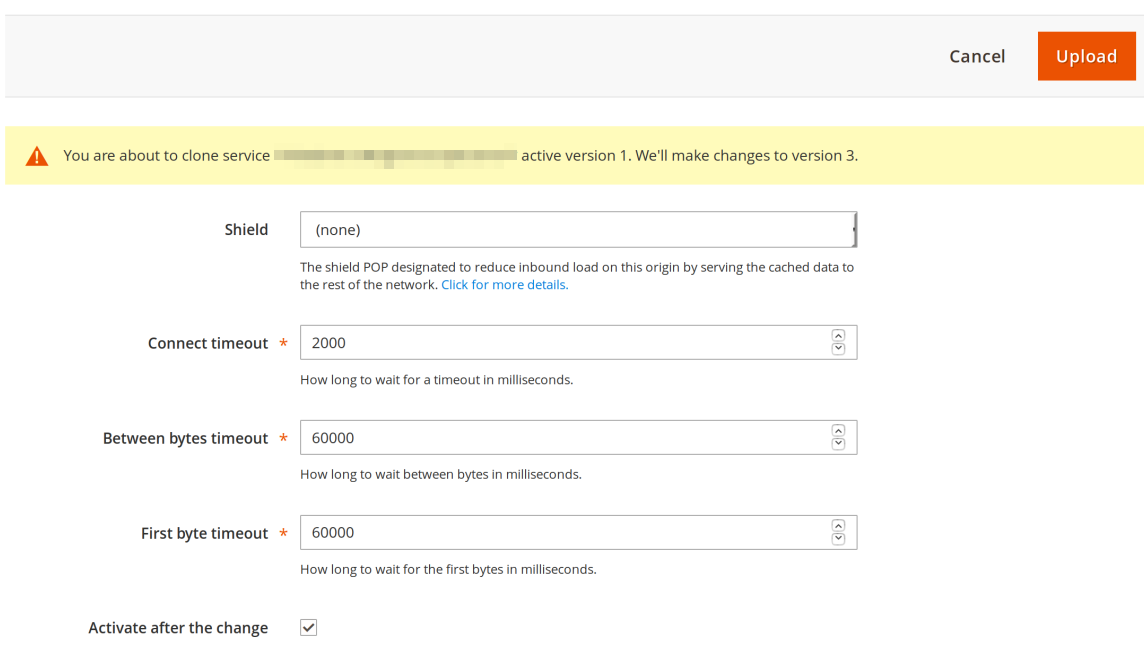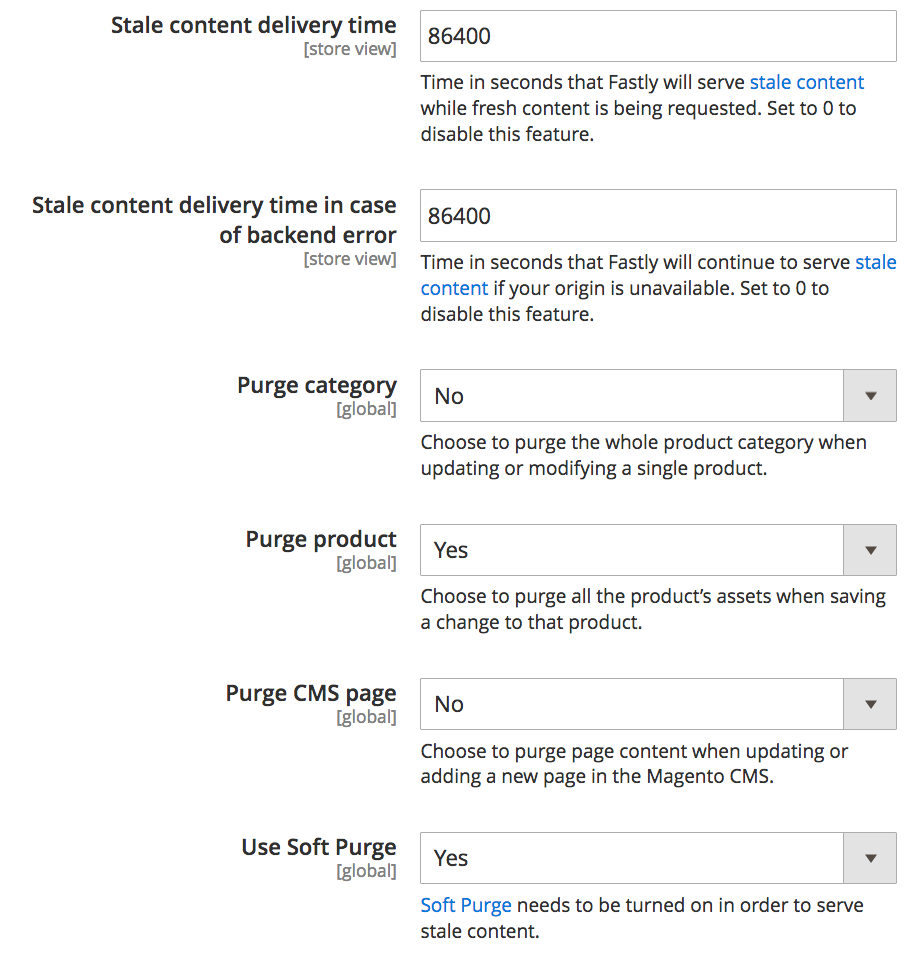Set up Fastly
Fastly is required for Magento Commerce Cloud, and is used in Staging and Production environments. It works with Varnish to provide fast caching capabilities and a Content Delivery Network (CDN) for static assets. Fastly is not available in Integration environments.
This information gets you started with enabling and configuring Fastly caching services in your Staging and Production environments. We provide additional information for configuring backends and Origin shields, customizing error pages, and adding custom VCL snippets.
For VCL snippets, experience developing that code is required for advanced configurations.
The process for configuring Fastly includes:
- Get Fastly credentials for Staging and Production environments
- Enable Fastly CDN caching in your environment
- Upload Fastly VCL snippets
- Advanced configurations including VCL snippets, as needed for your Magento Commerce sites
Get Fastly credentials
During project provisioning, Magento adds your project to the Fastly service account for Magento Commerce Cloud and adds the Fastly account credentials to the Staging and Production environment configuration.
You need the Fastly credentials to configure Fastly CDN services from the Magento Admin UI and to submit Fastly API requests.
Use the following methods to find and save the Fastly service ID and API token for your environment:
To view your Fastly credentials:
-
IaaS-mounted shared directory—On Pro projects, use SSH to connect to your server and get the Fastly credentials from the
/mnt/shared/fastly_tokens.txtfile. -
Local workspace—From the command line, use the Magento Cloud CLI to list and review Fastly environment variables.
1
magento-cloud variable:get -e <environment ID> -
Project Web UI—Check the following environment variables in the Environment configuration variables section.
-
CONFIG__DEFAULT__SYSTEM__FULL_PAGE_CACHE__FASTLY__FASTLY_API_TOKEN -
CONFIG__DEFAULT__SYSTEM__FULL_PAGE_CACHE__FASTLY__FASTLY_SERVICE_ID
-
If you cannot find the Fastly credentials for the Staging or Production environments, contact your Magento Technical Account Manager.
Enable Fastly caching for your Cloud environments
Prerequisites:
-
Latest version of the Fastly CDN for Magento 2 module installed in the Staging and Production environments. See Upgrade Fastly.
-
Fastly credentials for Magento Commerce Cloud Staging and Production environments
To enable Fastly CDN caching in Staging and Production:
-
Log in to the Magento Admin UI.
-
Click Stores > Settings > Configuration > Advanced > System and expand Full Page Cache.

-
In the Caching Application section, remove the selection from Use system value, and then select Fastly CDN from the drop-down list.

-
Expand Fastly Configuration and choose caching options.
-
After configuring the caching options, click Save Config at the top of the page.
-
Clear the cache according to the notification.
-
Navigate back to Stores > Settings > Configuration > Advanced > System > Fastly Configuration to continue configuring Fastly.
Test the Fastly credentials
-
On the Magento Admin UI, navigate to Stores > Settings > Configuration > Advanced > System > Fastly Configuration.
-
If needed, add the Fastly service ID and API token values for your project environment.

Ignore the link to create a Fastly API token. Use the Fastly credentials (Service ID and API token) that Magento provided.
-
Click Test credentials.
-
If the test succeeds, click Save Config, and then clear the cache.
If the test fails, verify that the correct service ID and API token values match the credentials for the current environment.
If the test fails again, submit a support ticket or contact your Technical Account Manager. For Pro projects, include the URLs for your Production and Staging sites. For Starter projects, include the URLs for your
Masterand Staging site.
If you need to change the Fastly API token credential for a Staging or Production environment, see Change Fastly credentials.
Upload VCL to Fastly
After you enable the Fastly module, upload the default VCL code to the Fastly servers. This code provides a series of VCL snippets that specify the configuration settings to enable caching and other Fastly CDN services for your Magento Commerce Cloud.
Fastly caching services do not work until you complete the initial upload of the Fastly VCL code for the Staging and Production sites.
To upload the Fastly VCL:
-
In the Fastly Configuration section, click Upload VCL to Fastly as the following figure shows.

-
After the upload completes, refresh the cache according to the notification at the top of the page.
Custom configuration
Before adding custom or advanced configuration settings like updating purge settings and configuring Fastly image optimization(Fastly IO), verify that the Fastly caching service works with the default configuration.
Configure the following features as needed:
- Configure backends and Origin shielding
- Customize response pages
- Enable additional Fastly configuration options
Configure backends and Origin shielding
Backend settings provide fine tuning for Fastly performance with Origin shielding and timeouts. A backend is a specific location (IP or domain) with configured Origin shield and timeout settings for checking and providing cached content.
Origin shielding routes all requests for your store to a specific Point of Presence (POP). When a request is received, the POP checks for cached content and provides it. If it is not cached, it continues to the Shield POP, then to the Origin server which caches the content. The shields reduce traffic directly to the origin.
The default Fastly VCL code specifies default values for Origin shielding and timeouts for your Magento Commerce Cloud sites. We recommend using the default values. In some case, you might need to modify the default values. For example, if you are getting a lot of time to first byte (TTFB) errors, you might need to adjust the first byte timeout value.
If you need to integrate additional backends into your site such as a backend to serve blog content from a Wordpress site, you must customize your Fastly service configuration to add the backend and handle the redirects from your Magento Commerce store to the Wordpress backend. For details, see Fastly Edge Modules - Other CMS/Backend integration in the Fastly module documentation.
To review the backend settings configuration:
-
Access and expand Fastly Configuration.
-
Expand Backend settings and click the gear to check the default backend. A modal opens that shows current settings with options to change them.

-
Select the Shield location (or datacenter) closest to your AWS region. For example, if Staging is on the west coast of the United States (us-west-1), select the
sjc-ca-usFastly shield location. This is the POP that provides caching services.The following list shows which Fastly shield locations to use based an AWS region:
- ap-east-1 => hongkong-hk
- ap-northeast-1 => tyo-tokyo-jp, hnd-tokyo-jp
- ap-northeast-2 => tyo-tokyo-jp, hnd-tokyo-jp
- ap-southeast-1 => singapore-sg
- ap-southeast-2 => sydney-au
- ap-south-1 => singapore-sg
- ca-central-1 => yul-montreal-ca, iad-va-us, dca-dc-us, bwi-va-us
- eu-central-1 => frankfurt-de, hhn-frankfurt-de
- eu-north-1 => stockholm-bma
- eu-west-1 => london-uk, london_city-uk
- eu-west-2 => london-uk, london_city-uk
- eu-west-3 => cdg-par-fr
- sa-east-1 => gru-br-sa
- us-east-1 => iad-va-us, dca-dc-us, bwi-va-us
- us-east-2 => iad-va-us, dca-dc-us, bwi-va-us
- us-west-1 => sjc-ca-us, pao-ca-us
- us-west-2 => sea-wa-us
-
Modify the timeout values (in microseconds) for the connection to the shield, time between bytes, and time for the first byte. We recommend keeping the default timeout settings.
-
Optionally, select to Activate the backend and Shield after editing or saving.
-
Click Upload to save your changes and upload them to the Fastly servers.
-
In the Magento Admin, click Save Config.
For more information, see the Magento 2 Backend settings guide in the Fastly module documentation.
Configure purge options
Fastly provides multiple types of purge options on your Magento Cache Management page including purging product category, product assets, and content. When enabled, Fastly watches for events to automatically purge those caches. If you disable a purge option, you can manually purge Fastly caches after finishing updates through the Cache Management page.
The options include:
- Purge category: Purges product category content (not product content) when you add and update a single product. You may want to keep this disabled and enable purge product, which purges products and product categories.
- Purge product: Purges all product and product category content when saving a single modification to a product. Enabling purge product can be helpful to immediately get updates to customers when changing a price, adding a product option, and when product inventory is out-of-stock.
- Purge CMS page: Purges page content when updating and adding pages to the Magento CMS. For example, you may want to purge when updating your Terms and Conditions or Return policy. If you rarely make these changes, you could disable automatic purging.
- Soft purge: Sets changed content to stale and purges according to the stale timing. In combination with the stale timings your customers will be served stale content very fast while Fastly is updating the content in the background.

To configure Fastly purge options:
-
In the Fastly Configuration section, expand Advanced.
-
All purge options display. Select “Yes” per purge option to enable automatic purging. Select “No” to disable automatic purging, allowing you to manually purge caches through the Cache Management page.
-
Click Save Config at the top of the page.
-
After the page reloads, click Upload VCL to Fastly in the Fastly Configuration section.
For more information, see the Fastly configuration options.
Create custom VCL snippets
For extensive instructions to create custom VCL snippets and needed edge dictionaries or ACLs, see Custom Fastly VCL snippets.
Extend Fastly timeout for the Magento Admin
Fastly sets a 180 second-timeout for HTTPS requests to the Magento Admin, so you may encounter timeouts if you need to complete bulk actions that take longer than 3 minutes. In these cases, update the Fastly service configuration to change the Admin path timeout.
-
In the Fastly Configuration section, expand Advanced.
-
Set the Admin path timeout value in seconds. This value cannot be more than 10 minutes (600 seconds).
-
Click Save Config at the top of the page.
-
After the page reloads, click Upload VCL to Fastly in the Fastly Configuration section.
Fastly gets the Magento Admin path for generating the VCL file from the app/etc/env.php configuration file.
Configure GeoIP handling
The Fastly module includes GeoIP handling to automatically redirect visitors or provide a list of stores matching their obtained country code. If you already use a Magento extension for GeoIP handling, you may need to verify the features with Fastly options.
-
In the Fastly Configuration section, expand Advanced.
-
Scroll down and select Yes to Enable GeoIP. Additional configuration options display.
-
For GeoIP Action, select if the visitor is automatically redirected with Redirect or provided a list of stores to select from with Dialog.
-
For Country Mapping, click Add to enter a two-letter country code to map with a specific Magento store from a list. For a list of country codes, see this site.

-
Click Save Config at the top of the page.
-
After page reload, click Upload VCL to Fastly in the Fastly Configuration section.
Fastly also provides a series of geolocation-related VCL features for customized geolocation coding.
DNS configuration
To enable Fastly caching on your Staging and Production sites, you need make the following changes to the DNS configuration for your site:
- Set all necessary redirects, especially if you are migrating from an existing site
- Set the zone’s root resource record to address the hostname
- Lower the value for the Time-to-Live (TTL) to refresh DNS information to point customers to the correct Production store
We recommend a significantly lower TTL value when switching the DNS record. This value tells the DNS how long to cache the DNS record. When shortened, it refreshes the DNS faster. For example, you can change the TTL value from 3 days to 10 minutes when you are testing your site. Be advised that shortening the TTL value adds load to the web server.
After checking with your registrar about where to change your DNS settings, add a CNAME record for your website that points to the Fastly service: prod.magentocloud.map.fastly.net. If you use multiple hostnames for your site, you must add a CNAME record for each one.
CNAME records cannot be set for apex domains, also referred to as a naked or base domains. You must use A records for this.
A records map a domain name to the following Fastly IP addresses:
151.101.1.124151.101.65.124151.101.129.124151.101.193.124
Refer to Go live checklist for more information.
TLS and Fastly
If you use TLS with Fastly enabled in your environment, you must provide your DNS provider with a TXT record from Fastly. We provide a Domain Validated SSL certificate with Subject Alternative Name enabled, issued by GlobalSign. When entering your Support ticket for DNS information and going live, let us know you are using TLS, provide your domain names, and request the TXT record. You can then send this record to your DNS provider. The domain validation process is executed by Fastly.
For details on this TXT record, see the Fastly DNS TXT record validation.
Upgrade the Fastly module
Fastly updates the Fastly CDN for Magento 2 module to resolve issues, increase performance, and provide new features. We recommend that you update the Fastly module in your Staging and Production environments to the latest version.
After you update the module, you must upload the VCL code to apply the changes to the Fastly service configuration.
To check the version of Fastly CDN module for Magento 2:
-
Change to the root directory of your Cloud environment.
-
Use Composer to check the installed version.
1
composer show *fastly*
-
If the latest releaseis not installed, complete the steps to upgrade the Fastly module.
To upgrade the Fastly module:
-
In your local Integration environment, use the following module information to upgrade the Fastly module.
1 2
module name: fastly/magento2 repository: https://github.com/fastly/fastly-magento2.git
-
Push your updates to the Staging environment.
-
Log in to the Magento Admin UI for your Staging environment to upload the VCL code.
-
Verify Fastly services on the Magento Commerce Staging site.
After you verify Fastly services on the Staging site, repeat the upgrade process in the Production environment.
If you have added a custom VCL snippet that has the same name as a default snippet, you may need to verify and update those snippets after you upgrade the Fastly module. We do not recommend replacing existing default snippets with custom snippets of the same name. For details on custom VCL, see Custom Fastly VCL snippets.